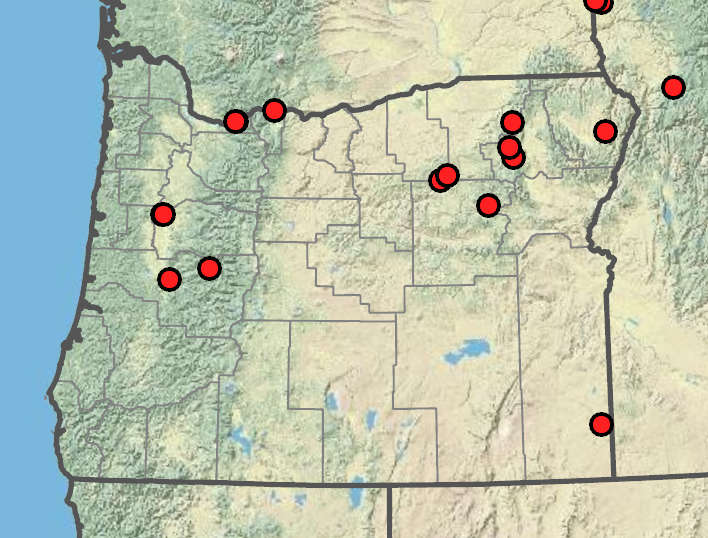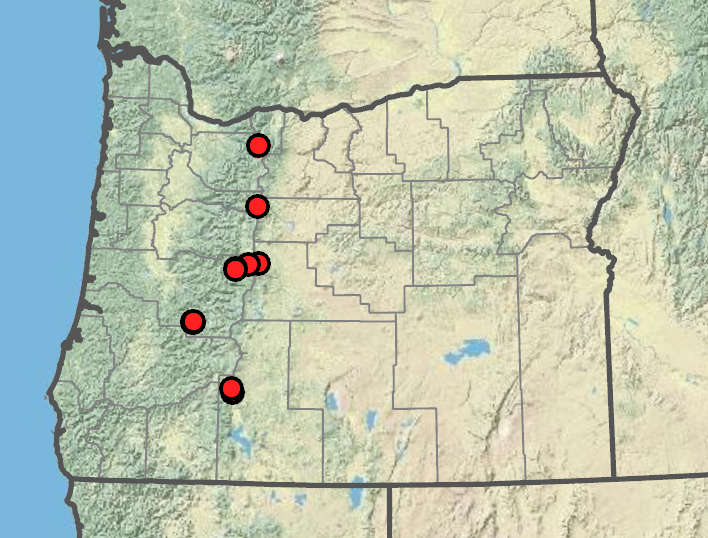Poa nemoralis
Poa chambersii
wood bluegrass, woodland bluegrass
Chambers' bluegrass
nodes slightly compressed, 2–5 exserted; the uppermost node in upper 25–50% of culm.
nodes terete, 0–1 exserted.
intraor extravaginal or mostly extravaginal.
intra- and extravaginal or mostly intravaginal.
sheaths closed to 20% of their length, bases of basal sheaths glabrous;
ligules 0.2– 0.8(1)mm long, truncate;
blades mostly flat, 0.8–3 mm wide.
sheaths closed 33–88% of their length, bases of basal sheaths glabrous;
collars smooth, glabrous;
ligules 0.5–2(2.5) mm;
cauline blades flat or folded, 2–5 mm wide; smooth or upper surface sparsely scabrous, mainly over the veins;
blades gradually reduced up the culm; uppermost blade 0.7–6 cm.
narrowly lanceoloid to ovoid, generally 25–40% as broad as long at maturity; erect, or nodding in shade forms, sparsely to moderately congested, 7–16(20) cm long;
branches ascending to widely spreading, 2–5 per node, fairly straight.
erect, lanceoloid to ovoid, tightly to loosely contracted, 2–9 cm;
spikelets 15–30;
proximal internodes less than 2 cm;
branches erect to ascending to slightly spreading, 1–2 per node, 0.9–3.2 cm, with 1–4 spikelets.
narrowly lanceolate to lanceolate; to 2.5–3.5 times as long as wide, 3–8 mm, usually not glaucous;
florets (1)2–5;
rachilla internodes mostly less than 1 mm.
to 3 times as long as wide, 6–12 mm;
florets 2–7;
rachilla internodes 0.8–1.5 mm long.
tapering from the base or narrowly lanceolate;
keels smooth or sparsely scabrous;
lower glumes 3-veined, 6.4–11 times as long as wide;
upper glumes shorter than or subequal to lowest lemma.
60–80% as long as adjacent lemmas;
lower glumes 3-veined.
with sparse, often short; cobwebby hairs.
of at least some lower florets with sparse cobwebby hairs, rarely all florets glabrous;
hairs 1–2 mm.
narrowly lanceolate to lanceolate, 2.4–4 mm; lower lemmas less than 20% as wide as long, distinctly keeled;
keels and marginal veins short-villous, intermediate veins glabrous; area between veins smooth or muriculate, glabrous;
tips acute, usually bronzecolored in part.
lanceolate, 5–7 mm, distinctly keeled; smooth or sparsely finely scabrous, glabrous throughout or keels and marginal veins sparsely soft-puberulent over the proximal 20%; area between the veins glabrous, 5–7-veined;
tips acute.
0.8–1.9 mm.
vestigial and 0.1–0.2 mm, aborted late in development, or 1.8–3.7 mm.
=28, 42.
Poa nemoralis
Poa chambersii
Moist, low elevation forests, streamsides, meadows. 50– 2000m. BW, Casc, ECas, WV. CA, WA; throughout most of North America; Eurasia. Exotic.
Poa nemoralis is a cespitose forest grass with short ligules and mostly open leaf sheaths. Similar P. interior has been reported from Oregon, but its presence here has not been confirmed. It has longer ligules and wider glumes and lemmas. Poa palustris has a more spreading growth form, culms branched above the base, well-developed callus hairs, narrow hyaline lemma margins, and incurving lemma keels.
Openings in upland forest and snowmelt pockets in alpine areas. 1700–2800m. BR, Casc. Native.
Although some plants may be pistillate, populations always include individuals with functional anthers. Poa chambersii is similar to P. wheeleri and P. cusickii ssp. purpurescens, but the latter have denser inflorescences and only pistillate spikelets. Poa chambersii populations in the Cascades are dioecious; those on Steens Mountain are gynodioecious and will be described as a new species in the future.
Rob Soreng, Barbara Wilson, Richard Brainerd, Nick Otting
Rob Soreng, Barbara Wilson, Richard Brainerd, Nick Otting
- Local floras:
BC,
CA,
OR,
WA
- Local Web sites:
CalFlora,
CalPhotos,
Flora NW,
PNW Herbaria
WildflowerSearch
iNaturalist (observations)
USDA Plants Database
- LBJ Wildflower Center
- SEINet
- Plants of the World Online
- Encyclopedia of Life
- Wikipedia
- Google Image Search



